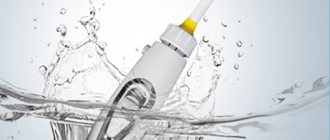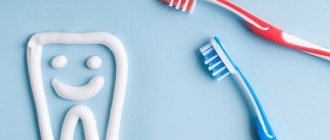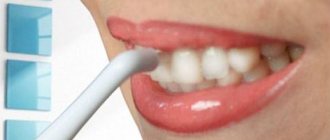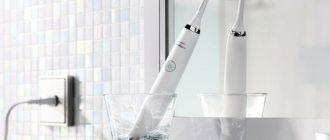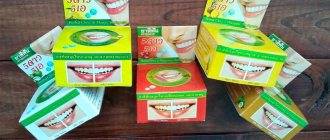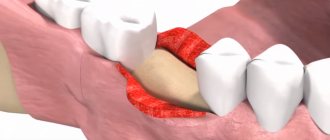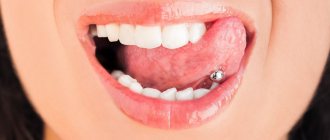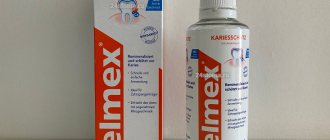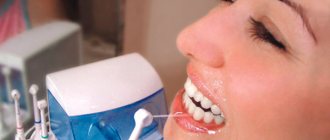Irrigators are devices that help maintain oral hygiene and clean teeth from plaque and food debris. They make it very easy to care for crowns, braces and dentures. Not everyone knows how to select such devices correctly. Let's list the selection criteria and make a rating of the best irrigators.
Irrigators work on the following principle: a device inside the device delivers a pulsating stream of water or other liquid under pressure into a special tube. By targeting the teeth with this jet, plaque and food debris are removed. The gums are also massaged using an irrigator.
In this article
- Purpose of the irrigator
- Who should not use an irrigator
- Types of irrigators: which one is better
- Types of irrigators according to operating principle
- Features of pulsed oral irrigators
- Microbubble oral irrigator
- The best irrigators - what are they?
- Good irrigators of 2021
- Rating of good portable irrigators
Various types of these devices are produced, which differ in several indicators: power, number of pulsations per minute, functionality, etc. Let's look at these nuances. Let's find out what criteria should be taken into account when purchasing and list the top 10 oral irrigators, which are recommended by doctors and are in demand among customers of our online store.
Why do you need an irrigator?
- For the prevention of caries. The irrigator helps get rid of plaque on the teeth and tongue. It also cleans hard-to-reach areas such as molars, wisdom teeth, interdental spaces and orthodontic appliances.
- For the prevention and treatment of gum diseases. The irrigator improves blood circulation and accelerates regeneration processes. This helps strengthen the gums and reduce bleeding.
- For the care of implants, crowns, bridges, braces and other structures. The irrigator washes them and the cavities underneath them.
- To eliminate the cause of bad breath - bacterial plaque.
- For the prevention of gingivitis. The disease can occur in pregnant and lactating women due to deterioration of blood supply to the mucous membranes.
There are no contraindications to using the irrigator.
Content:
- What is this?
- How Irrigation Systems Work - A Brief Overview
- Who should buy
- What to look for when choosing
- Types of equipment for cleaning technology
- Which irrigator is better - choosing the right device for teeth
- How to use it correctly
- When not to use
To ensure the best possible care for your teeth and gums, it is not enough to use only toothpaste, brush and floss. It is also advisable to arm yourself with an oral irrigator. By choosing the best device for yourself, a person will be able to avoid many dental diseases and problems.
Types of irrigators
Irrigators are stationary and portable. For home use, it is better to choose a stationary one - it is more reliable and will last longer. Some of these devices can be mounted on the wall. This is useful if you have limited sink space.
If there is no outlet in the bathroom, you can choose a portable irrigator - it runs on a battery and can be charged anywhere. A portable irrigator is lighter and smaller than a stationary one, and is convenient to take on trips.
The first important parameter for choosing an irrigator is the power of the water jet.
.
A portable irrigator must have a power of at least 520 kilopascals (kPa), and a stationary one must have a power of at least 550 kPa. The second selection parameter is the number of jet pulsations
per minute. The optimal value is 1200 pulsations.
Irrigators also differ in their mode switching
. For stationary ones, mode switching occurs smoothly, for portable ones - stepwise. If the waterpik is used by children or people with gum disease, it will be more difficult for them to adjust the comfortable power on a portable one.
Comparison of popular models
To help you make the right choice, we have prepared comparison tables of stationary and portable irrigators. All important characteristics of the devices are listed here.
Stationary irrigators
| Waterpik WP-100 E2 Ultra | Revyline RL 100 | Waterpik WP-660 Aquarius | Revyline RL 500 | Aquajet LD-A8 | B.Well WI-922 | Donfeel OR-820D Compact | Donfeel OR-840 AI | CS Medica AquaPulsar CS-2 | |
| Tank volume, ml | 650 | 600 | 650 | 600 | 500 | 600 | 600 | 600 | 500 |
| Number of nozzles | 7 | 7 | 7 | 7 | 5 | 7 | 8 | 5 | 5 |
| Guarantee | 2 years | 2 years | 2 years | 2 years | 1 year | 2 years | 1 year | 1 year | 2 years |
| Power | from 70 to 690 kPa | from 210 to 870 kPa | from 70 to 690 kPa | from 210 to 870 kPa | from 290 to 810 kPa | from 207 to 827 kPa | from 100 to 650 kPa | 80 - 680 kPa | from 150 kPa to 850 kPa |
| Number of pulsations, min | 1400 | 1200-1700 | 1400 | 1200-1700 | 1200 | 1250-1850 | 1250 — 1550 | 1250 — 1700 | from 1100 to 1600 |
| Wall mount | No | No | No | No | There is | No | No | No | There is |
Portable irrigators
| Waterpik WP-450 | Revyline RL 450 | Philips Sonicare AirFloss Ultra HX8381/01 | Panasonic EW-DJ40 | Panasonic EW1211A | Revyline RL 200XL | B.Well WI-911 | B.Well WI-912 | CS Medica AquaPulsar CS-3 Basic | |
| Tank volume, ml | 210 | 240 | 15 | 165 | 130 | 300 | 150 | 150 | 130 |
| Number of nozzles | 4 | 5 | 1 | 1 | 2 | 2 | 2 | 5 | 2 |
| Guarantee | 2 years | 2 years | 2 years | 2 years | 2 years | 2 years | 1 year | 1 year | 2 years |
| Power | from 310 to 520 kPa | from 130 to 760 kPa | 390 and 590 kPa | from 200 to 590 kPa | from 210 to 700 kPa | 275 - 620 kPa | 378 - 720 kPa | up to 590 kPa | |
| Number of pulsations, min | 1450 | until 1700 | 1400 | 1400 | 1400-1800 | 1600 | 1420 | 1200 — 2000 |
Patient reviews
“The doctor forbade me to use the irrigator - I had ceramic braces, he said that they would come off on me. And I read on the forums more than once that people use it. But I didn’t risk it..."
Irina P., 26 years old, Moscow
“The irrigator became my salvation!!! Cleaning braces is just some kind of hell, you can’t get anywhere. I purchased the device long before installing the bracket system, because... I had problems with my gums. I used it after every meal - I walked quickly, knocked the food out from under my braces and no brushes were needed. Very comfortably"
Marina Nikolaeva, Volgograd
Nozzles and their types
The irrigator comes with one or more attachments. Remember that each family member should have their own nozzle. Nozzles can be purchased and changed. They come in several types.
- The standard
brush head is suitable for cleaning healthy teeth and gums. - An orthodontic
attachment is needed to remove plaque under braces and under the gingival margin. For these purposes, you can use a standard attachment, but the orthodontic one is more convenient. - A periodontal
nozzle with a thin soft rubber tip directs the jet beyond the gingival margin and into the periodontal pockets. It should not be used at maximum power - otherwise it may suddenly fly off or tear. - Nozzle for implants
, crowns and bridges - with 3 tufts of bristles for easy cleaning of structures. - The tongue cleaner
removes plaque from the tongue and cheeks, eliminating the cause of the unpleasant odor. - For additional plaque removal there is a brush attachment
. But it does not replace a regular toothbrush. - A nasal nozzle
is needed to irrigate the nasal cavity during the treatment or prevention of rhinitis and sinusitis.
Standard attachments need to be changed approximately every six months, and periodontal, orthodontic and brush attachments - every 3 months. Remember that each family member should have their own nozzle.
Instructions for use
The use of the device begins with its preparation. To do this, the tank is filled with warm water, which must be cleared of various impurities.
If the device is being used for the first time, it is necessary to perform additional cleaning by collecting a full container of water and passing it through the nozzle in the standard mode. Then set the required mode and water supply speed.
The cleansing procedure must be carried out by bending over a container or sink into which water from the oral cavity will drain.
Is it always possible to wear braces during pregnancy? We’ll talk about it in the next review.
In this material we will discuss how to correct mesial overbite.
Here https://orto-info.ru/ortodonticheskoe-lechenie/osnovnoy-period/vosk-dlya-breketov.html we’ll figure out what protective orthodontic wax for braces is.
Cleaning is carried out in several steps:
- the mouth is opened slightly so that the water can flow freely, and the nozzle is directed to the dentition, starting with the last molars;
- First, each bracket is cleaned, paying special attention to the lock and the area where the system adheres to the enamel surface;
- after this, direct the jet to the gum line area and the spaces between the teeth;
- the remaining surface of the dentition is treated last.
In conclusion, it is recommended to massage the periodontium, gently acting on it with a stream of water.
How to clean braces with an irrigator, watch the video:
After the procedure, the device must be completely emptied and dried if possible.
Balms for irrigator
The use of special balms for the irrigator can enhance the effect of the procedure, as their components have antibacterial and anti-inflammatory properties. The choice of liquid depends on your goals. Some liquids help strengthen enamel, others are effective against inflammatory gum diseases, and others have a complex effect. On our website you can buy liquids for irrigators from the companies Waterdent, Donfeel, Professor Persin, Albadent, Asepta, ROCS and Iriks. It is profitable to buy sets of several bottles.
How to choose a liquid for an irrigator
When choosing a liquid for an irrigator, you should take into account its composition and purpose. You should not pour hard running water into the irrigator - it may contain impurities harmful to the enamel, and it can also lead to damage to the device over time. Depending on the active substances, solutions will help solve different problems. They come in 4 types.
- Strengthening enamel
- with fluoride. - Therapeutic and prophylactic
- with antiseptics and plant extracts. - For fresh breath
- with mint, menthol or eucalyptus. - For the treatment of periodontal disease
- with bioantioxidants and anti-caries additives.
Allergy sufferers are advised to choose hypoallergenic balms.
How Irrigation Systems Work - A Brief Overview
To make it easier for a person to understand which irrigator to buy, it is necessary to first understand the operating principles of different models. The jet in various devices can be:
- continuous;
- pulsating;
- including microscopic bubbles.
It is permissible to fill the system with ordinary running water or a special dental solution. A large selection of tips and the option of supplying jets of different power allow you to fully rinse hard-to-reach areas that cannot be reached with a conventional brush.
Irrigator care
Here are a few rules for caring for your irrigator.
- Do not touch the charger with wet hands
. - Do not allow the plugged-in device to come into contact with water
. - Carefully monitor the integrity of the cord
. - Do not wipe the housing with alcohol
. - Do not place the device near heating devices
. - Fill the reservoir only with water and special balms
for the irrigator. - While the irrigator is operating, do not hold the pause button for long
- the motor may burn out. - Use only attachments recommended by the manufacturer
. - If you take the irrigator on the road in winter, there should be no water in it
- otherwise it will freeze and the device will break. To remove all the water, turn on the irrigator. Let it run until all the liquid comes out.
How to use it correctly
The devices are very easy to use. Before you turn them on, you need to brush your teeth the old fashioned way - with a brush and toothpaste. Only after this proceed to treating the interdental spaces with water flow. The reservoir can be filled with dental solution prescribed by your doctor.
The tip must be held in such a way that the jet is delivered at an angle of 60 to 90 degrees. The duration of the cleansing procedure should be up to ten minutes. Children under six years of age may only use the equipment under parental supervision. It is forbidden to mess with him.
Misconceptions
❌ An irrigator can replace a toothbrush
Using a toothbrush is essential for quality oral care. An irrigator is an additional hygiene product; it can replace dental floss, but not a brush with toothpaste.
❌ It is enough to use the irrigator a couple of times a week
The irrigator should be used every time after brushing your teeth, that is, in the morning and in the evening.
❌ You definitely need to use balms for irrigators
You can use an irrigator with regular warm water. It must be filtered or boiled. Irrigator balms help fight some diseases, but their use is not necessary.
❌ You can pour herbal decoctions and regular rinses into the irrigator
Only water and special balms can be poured into the irrigator. Mouthwashes foam heavily in the reservoir, and herbal infusions leave a sediment. All this can quickly break the device.
❌ The fluid supply hose must be long
The hose should not be too long, as you will still have to bend over the sink when using the irrigator. There is no point in using the device while standing.
❌The more power levels the irrigator has, the better it is
Modern irrigators have smooth power adjustment, and the number of divisions on the toggle switch is quite arbitrary.
What it is?
An irrigator is a small device that cleans teeth and orthodontic structures by applying a pressurized water jet to them. The device has one or two built-in pumps that draw liquid from the container.
In some cases, during the water supply process, it mixes with air, forming many microbubbles. When the jet hits the surface of the teeth, these bubbles break, disrupting the adhesion of plaque and knocking out food debris from narrow areas that are difficult to reach with a regular brush.
This is very important when wearing braces, which are characterized by the complexity of the design of the lock and other connection elements .
The irrigator has certain advantages over a regular toothbrush when used during the correction period:
- professional-level cleansing, since the flow of water enters the areas under the brackets, arches and the places where the braces join the enamel surface;
- the possibility of spot processing, due to which high-quality cleaning of the lock is carried out;
- gentle cleaning of ceramic braces, eliminating the possibility of damage;
- expanded functionality: its action is identical to the combined use of a dental brush and floss.
The irrigator is used after basic brushing with a regular toothbrush. To fill it, you can use not only ordinary water, but also medical solutions, balms and decoctions.
Replaceable attachments of the device allow all family members to use it.
Which one is better to choose?
The maximum effect from an irrigator when cleaning braces can only be achieved if the correct model is selected . These devices are presented on store shelves in a wide range.
The models differ from each other in type of construction, functionality and external design.
Total: which irrigator is better to choose?
The choice of irrigator depends on your lifestyle, the nature of your dental problems and the number of future users.
Stationary or portable
If you need the device on business trips and trips, choose a portable, travel irrigator. Pay attention to the volume of the tank, the presence of a carrying case and the battery capacity. When choosing a portable irrigator, check whether it has a battery charge indicator. If it is not there, a sudden discharge of the device may be an unpleasant surprise.
If it is possible to install a stationary device at home, choose it, it will last longer. When purchasing, pay attention to the length of the network cable - it should allow you to place the device in a convenient place. The advantages of a stationary irrigator include high power, a spacious tank, and a large selection of nozzles.
Recommendations
- If you need an irrigator for braces
, dentures or crowns, choose an irrigator with a special attachment included. - If you are buying a irrigator for a large family
, choose models with a large tank and the required number of nozzles. - If the irrigator will be used by children or people with gum disease
, the operating mode should be more gentle. The lower the minimum power of the device, the more comfortable they will be. Also in this case, smooth power control is important.
Modes
Basically, when choosing an irrigator for cleaning the bracket system, dentists recommend focusing on the number of modes and their functionality.
Most often they are equipped with the following modes :
- Standard . This mode is available on all types of irrigators. It is a monostream, supplied in one continuous stream. It has good washing ability, but is ineffective for cleaning braces.
- Pulsating .
It is supplied in the form of a pulsating thin jet that delivers micro-impacts that effectively remove deposits by breaking their bond with the surface. A thin jet allows you to target the elements of the orthodontic structure and clean its most inaccessible areas. - Microbubble. This mode not only allows you to completely remove plaque, but also has an antibacterial effect.
Microbubble mode technology involves the simultaneous supply of water and air, which are mixed during the intake process.When such a jet is applied to the surface to be cleaned, microbubbles penetrate into all corners of the structure and burst, creating an explosion effect, which helps to destroy bacterial plaque and wash it out of the system.
In addition to the jet modes, it is necessary to pay attention to the possibility of adjusting the flow rate of the water flow. This will allow the treatment to be carried out by people with both normal gum sensitivity and increased sensitivity.
